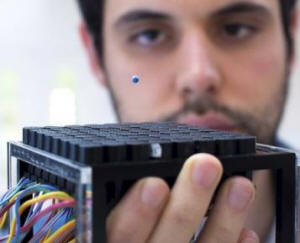|
 Tractor
beams of science fiction becoming a reality Tractor
beams of science fiction becoming a reality
 Send a link to a friend
Send a link to a friend
[October 28, 2015]
By Will Dunham
WASHINGTON (Reuters) - The tractor beam, a
staple of science fiction including "Star Wars" and "Star Trek" that is
employed to grab spaceships and other things remotely, is entering the
realm of reality.
|
|
 Researchers on Tuesday said they have developed a tractor beam
that uses high-amplitude sound waves to levitate, move and rotate
small objects without making contact with them. They envisioned
medical and other applications for the device. Researchers on Tuesday said they have developed a tractor beam
that uses high-amplitude sound waves to levitate, move and rotate
small objects without making contact with them. They envisioned
medical and other applications for the device.
"As a mechanical wave, sound can exert significant forces on
objects. Just remember the last time you were in a concert and your
chest was vibrating with the music," said study lead author Asier
Marzo of Britain's University of Bristol and Spain's Public
University of Navarre.
Marzo said this sonic tractor beam has manipulated objects up to
about one-seventh of an inch (4 mm) in diameter and can control the
position and orientation of the levitated objects.
The tractor beam uses ultrasound at a frequency of 40 kilohertz.
People can hear only below 20 kilohertz.
 The researchers used sound waves from 64 miniature loudspeakers
called transducers to create what they called "acoustic holograms"
to control an object without touching it. These waves took the form
of tweezers to lift an object, a vortex to hold a levitating object
in place and a cage to surrounds an object and hold it in place.
"A simple wave will just push the particle in the direction of
propagation. However, multiple waves will interfere with each other
and create complex, acoustic 3D shapes that exert forces from all
directions and keep the particle in place," Marzo said.
Marzo said the largest object moved using the device was a 4 mm bead
made of a light plastic called polystyrene.
[to top of second column] |

"With special high-power transducers it would be possible to
levitate even steel balls," Marzo said.
Marzo described possible medical applications.
"Sound cannot travel through the void of space but it can do it
through water or human tissue. This potentially enables the
manipulation of clots, kidney stones, drug capsules, microsurgical
instruments or cells inside our body without any incision," Marzo
said.
More powerful sonic tractor beams capable of levitating bigger
objects from greater distances could control objects floating adrift
in zero-gravity environments like inside the International Space
Station, Marzo said.
The research, which also involved researchers at Sussex University
and a British company called Ultrahaptics, was published in the
journal Nature Communications.
(Reporting by Will Dunham; Editing by Sandra Maler)
[© 2015 Thomson Reuters. All rights
reserved.]
Copyright 2015 Reuters. All rights reserved. This material may not be published,
broadcast, rewritten or redistributed.
 |